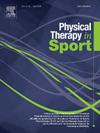检查前交叉韧带重建后的神经认知特征和单肢着陆力学
IF 2.2
3区 医学
Q1 REHABILITATION
引用次数: 0
摘要
目的:研究神经认知能力与单肢着地生物力学的关系。比较前交叉韧带重建(ACLR)患者与未受伤对照组的神经认知表现。参与者:18名患有ACLR的参与者和18名未受伤的对照组。主要结果测量:脑震荡后立即评估和认知测试:视觉记忆、视觉运动和反应时间综合评分。单肢着地生物力学:膝关节屈曲角峰值、膝关节内收力矩峰值和地面反作用力峰值。结果神经认知能力与单肢着地生物力学性能之间无统计学意义。患有ACLR的个体和未受伤的对照组表现出相似的神经认知表现(所有p >;. 05)。结论:单肢着地生物力学与神经认知表现之间缺乏相关性,这可能表明计算机化神经认知评估不够敏感,无法识别与前交叉韧带损伤相关的生物力学负荷模式。神经认知-运动评估,特别是挑战膝关节运动控制可能更适合辨别高和低神经认知概况。本文章由计算机程序翻译,如有差异,请以英文原文为准。
Examining neurocognitive profiles and single-limb landing mechanics following anterior cruciate ligament reconstruction
Objectives
1) Determine the relationship between neurocognitive performance and single-limb landing biomechanics 2.) Compare neurocognitive performance between individuals with anterior cruciate ligament reconstruction (ACLR) and uninjured controls.
Design
Cross-Sectional.
Setting
Laboratory.
Participants
Eighteen participants with ACLR and 18 matched uninjured controls.
Main outcome measures
Immediate Post-Concussion Assessment and Cognitive Testing: Visual Memory, Visual-Motor and Reaction Time Composite Scores. Single-limb landing biomechanics: peak knee flexion angles, peak internal knee adduction moments, and peak ground reaction forces.
Results
There were no statistically significant correlations between neurocognitive performance and single-limb landing biomechanics. Individuals with ACLR and uninjured controls exhibited similar neurocognitive performance (all p > .05).
Conclusions
The lack of associations between single-limb landing biomechanics and neurocognitive performance may suggest that computerized neurocognitive assessments are not sensitive enough to identify individuals demonstrating biomechanical loading patterns associated with ACL injury. Neurocognitive-motor assessments that specifically challenge knee motor control may be more appropriate to discern high and low neurocognitive profiles.
求助全文
通过发布文献求助,成功后即可免费获取论文全文。
去求助
来源期刊

Physical Therapy in Sport
医学-康复医学
CiteScore
4.50
自引率
8.30%
发文量
125
审稿时长
39 days
期刊介绍:
Physical Therapy in Sport is an international peer-reviewed journal that provides a forum for the publication of research and clinical practice material relevant to the healthcare professions involved in sports and exercise medicine, and rehabilitation. The journal publishes material that is indispensable for day-to-day practice and continuing professional development. Physical Therapy in Sport covers topics dealing with the diagnosis, treatment, and prevention of injuries, as well as more general areas of sports and exercise medicine and related sports science.
The journal publishes original research, case studies, reviews, masterclasses, papers on clinical approaches, and book reviews, as well as occasional reports from conferences. Papers are double-blind peer-reviewed by our international advisory board and other international experts, and submissions from a broad range of disciplines are actively encouraged.
 求助内容:
求助内容: 应助结果提醒方式:
应助结果提醒方式:


